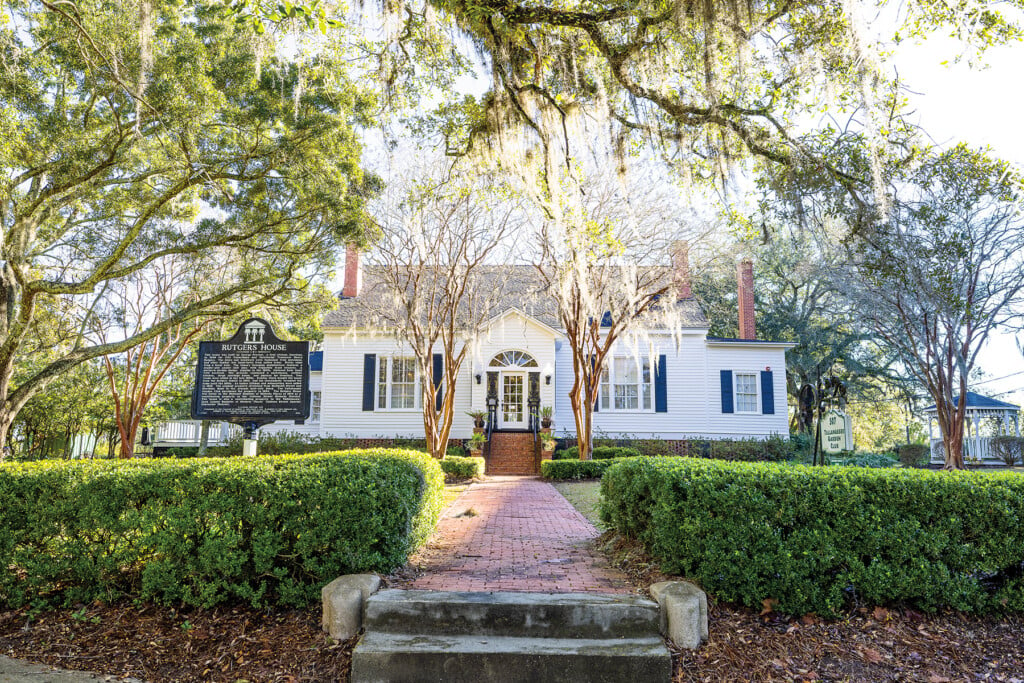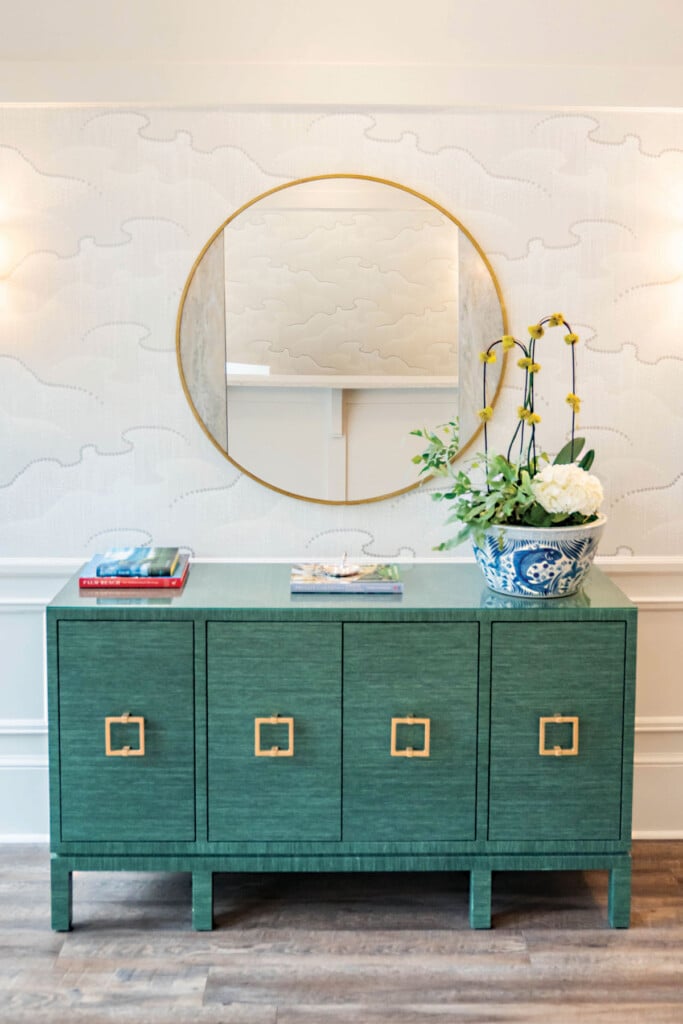The Gold Dust Streets
A look at one of Tallahassee’s historic districts yesterday and today

Setting the Stage
In 1824, Tallahassee, the halfway point between Pensacola and Jacksonville, must have seemed the perfect place to set up a new capital city. Still a territory, Florida wouldn’t become a state until 21 years later. Yet planters and entrepreneurs knew opportunity when they saw it. Mild winters and sunny skies, as well as connections to ports like New Orleans, held promise for the accumulation of great wealth. The early founders were right about the money, and the new residents wasted no time in figuring out how to spend it.
Tallahassee at its birth was platted as only one square mile. Planners laid out Adams, Calhoun, and Gadsden streets surrounding the Capitol building. It was along these dirt roads that newcomers from Virginia, the Carolinas, and Georgia began to build businesses, churches, banks, and magnificent homes. Along the originally platted streets sprawled gabled houses under live oaks, with sweeping verandas, elegant gardens, carved balustrades, and long shutters to keep out the warm Southern sun.
Listed on the National Register of Historic Places, the Calhoun Historic District still maintains 16 homes from the era. What were once known as the “Gold Dust Streets” are now bordered by high-rise apartment buildings, towering banks, and the State Capitol. Just blocks away from busy thoroughfares and two university campuses, the district remains an oasis of the past.
A shady stroll along the slightly undulating sidewalks takes you past houses like the Perkins House, the Chittenden House, Bloxham, and Bowen, all named for famous residents or owners. They’re now lovingly maintained by professional occupants from attorneys and doctors to history lovers, and it is not unusual to see business meetings conducted on a wide veranda. “I used to drive to downtown meetings,” says Gary Yordon of the Zachary Group, which rents space in attorney John Moyle’s Perkins House. “But now I walk everywhere. The air is different here—[it’s] from another time, and peaceful.”

Photo by Gabriel Hanway
In a time of no air-conditioning, most homes were built with wide central halls and a dramatic stairway flanked by high-ceilinged parlors or sitting rooms. Six or seven fireplaces were not uncommon. Kitchens were unattached to the main house, as were sanitary facilities. Today, many homes are lovingly maintained and decorated with period furniture, showing off the “tiger-oak carvings of a fireplace,” unique “tripartite design of windows,” or the gleaming resiliency of wide-planked heart pine floors.
But what was life like before the Civil War? Even before the last of the three Seminole Wars?
Nancy Steadman, a realtor and history buff, looks to the early 1820s, when Florida was a territory created from the lands of the Seminole tribe. From 1817 until 1858, three conflicts concluded with the indigenous people being expelled from the area that had become Tallahassee. A 200-foot-wide “no-man’s land” was cleared as a buffer along what is now Park Avenue to prevent attacks from local Native American tribes. Today’s Chain of Parks Art Festival is celebrated along this wide esplanade once known as “200 Foot Street.”
Most of the Federalist, Georgian, and Queen Anne-style homes in the Historic District were constructed by enslaved persons who were brick artisans and excellent carpenters. There was, however, at least one exception: George Proctor.
George Proctor was a free Black man. His father, Antonio Proctor, was born enslaved in the Dominican Republic. But, Antonio could speak Native American dialects, and he gained his freedom and praise when he assisted in treaties with Florida’s indigenous inhabitants. George, also free, became an architect and builder in the new capital, creating four of the most iconic homes in the city, including the current home of the Tallahassee Garden Club.

Photo by Marshall Moyle_Megafauna Films
Yet for well-to-do white residents and the entrepreneurs who sought their fortunes in antebellum Tallahassee, and even after the War of the States, life in the capital’s downtown nucleus was filled with excitement and “curiosities.” Below are a few examples from historians David Lang, Julian Proctor, and Joy Hevey:
Though so much has changed in Florida’s capital, there seems to linger along these quiet, historic streets a nostalgia that both acknowledges the injustices of the period and cherishes the vision that the early creators brought to fruition. Like benevolent overseers, the great oaks still arch across these gardens and roofs and somehow sequester memories here.
On a quiet afternoon, you might even imagine soft laughter and the creak of carriage wheels on old brick. Or even the swish of an alligator tail along the pavement.
So, take a walk on the Gold Dust Streets. Listen. And maybe look for a porch swing gently swaying—even when you know nobody’s there.
The
Bowen House
325 North Calhoun Street
Built by merchant and two-time Tallahassee Mayor James Kirksey, the circa-1830s Bowen House is thought to be the oldest “prefabricated” home in the state, its white pine traveling from New York to New Orleans and via St. Mark’s to Tallahassee. No nails were used; only morticed wood and pegs. It features a Greek Revival style, with elegant double-storied wraparound verandas supported by glistening white pillars. The home is currently the law office of attorney Tiffany Cruz.
Rutgers House
507 North
Calhoun Street
Though appearing smaller than other mansions, this 5,000-square-foot Queen Anne–style home was built by George Proctor—another prefabricated and shipped, no-nails home—for Henry Rutgers, a banker and former Territorial Treasurer. The home was acquired by Erastus Clark, a jeweler and watchmaker whose family kept cows in the back pasture and sold milk. Later, it is rumored that Clark’s elderly daughters drew straws as to who would marry the property’s caretaker so that he might stay inside the house on cold nights. It is currently the home of the Tallahassee Garden Center and the Tallahassee Symphony.

Photos by Haley Jacobs Homeshot Media
ThePerkins House
118 North Gadsden Street
The grand 8,000-square-foot mansion was built for George Betton Perkins in 1903 and is currently owned by attorney Jon Moyle, who loves history and being its steward. The three-story building boasts shallow tile-faced fireplaces in every room, each one flanked by hand-carved gargoyles and mirrors. Moyle rents the upstairs rooms as offices and uses the downstairs as reception and meeting rooms and for his own sprawling office. His desk sits beneath an internal “arched portico” overlooking a room of period furniture.
The Bloxham House
410 North
Calhoun Street
Built by Richard Shine in 1844, the 4,972-square-foot home was owned by the proprietor of a department store, was the residence of two-time Governor William Bloxham (who rented it to his successor between terms), and became the well-known White House Hotel in the 1940s. Later, it housed World War II recruits during training. In 1979, new owners Robert and Frances Erwin had the entire stairwell “moved back to its original position in the entry hall” and the old hotel’s reception desk removed.
The Gladstone
On October 14, 2024, it only took a few hours to rip apart a 127-year-old home that once stood beneath storybook oaks and shared a strip of Tallahassee’s tree-canopied North Monroe Street with other Victorian mansions—now all long gone. After months of haggling, the State of Florida, which had owned the Gladstone House since 2021, declined to either restore, move, or sell the property, and instead tore it down to provide better security for the Governor’s Mansion that sits behind it.
Acknowledgements:
Bob Hollaway, Tallahassee Historical Society; David Lang, historian and past president of Tallahassee Historical Society; Julian Proctor (no relation to George Proctor), lifetime resident of Tallahassee; Nancy Steadman, realtor with Coldwell-Banker; Joy Hevey, Susan Weaver, and members of the Tallahassee Garden Club for so much generosity in sharing Tallahassee’s history.


